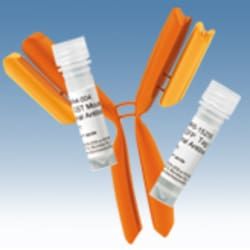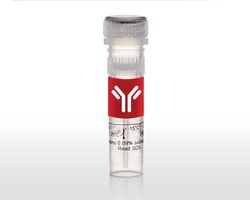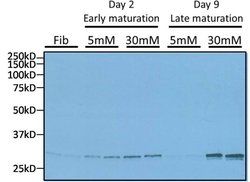beta Amyloid Monoclonal Antibody (DE2B4), Invitrogen™
Manufacturer: Thermo Scientific
Select a Size
| Pack Size | SKU | Availability | Price |
|---|---|---|---|
| Each of 1 | MA124966-Each-of-1 | In Stock | ₹ 53,311.00 |
MA124966 - Each of 1
In Stock
Quantity
1
Base Price: ₹ 53,311.00
GST (18%): ₹ 9,595.98
Total Price: ₹ 62,906.98
Antigen
beta Amyloid
Classification
Monoclonal
Concentration
1 mg/mL
Formulation
PBS with 0.09% sodium azide
Gene Accession No.
P05067
Gene Symbols
APP
Immunogen
Synthetic peptide corresponding to residues 1-17 of human beta Amyloid.
Quantity
50 μg
Primary or Secondary
Primary
Target Species
Human
Product Type
Antibody
Isotype
IgG1
Applications
ELISA, Immunocytochemistry, Immunohistochemistry (Paraffin), Immunoprecipitation, Western Blot
Clone
DE2B4
Conjugate
Unconjugated
Gene
APP
Gene Alias
A4; AAA; ABETA; Abeta40; Abeta42; ABPP; AD1; Adap; AG; AICD-50; AICD-57; AICD-59; AID(50); AID(57); AID(59); Alpha-CTF; Alpha-secretase C-terminal fragment; Alzheimer disease; Alzheimer disease amyloid A4 protein homolog; alzheimer disease amyloid protein; Amyloid; amyloid A4; Amyloid b; Amyloid beta; amyloid beta (A4) precursor protein; amyloid beta (A4) precursor protein (peptidase nexin-II, Alzheimer disease); amyloid beta A4 protein; amyloid beta precursor protein; Amyloid intracellular domain 50; Amyloid intracellular domain 57; Amyloid intracellular domain 59; Amyloid precursor protein; amyloid precursor protein variant 1; amyloid precursor protein variant 2; Amyloid β; amyloid-beta A4 protein; amyloid-beta A4 protein; amyloid beta A4 protein; Amyloid-beta precursor protein; Amyloid-beta protein 40; Amyloid-beta protein 42; Amyloidogenic glycoprotein; APP; APP-C57; APP-C59; APP-C99; APPI; appican; beta amyloid protein; beta amyloid protein precursor; beta-amyloid peptide; beta-amyloid peptide(1-40); beta-amyloid peptide(1-42); Beta-amyloid precursor protein; betaApp; Beta-APP40; Beta-APP42; Beta-CTF; Beta-secretase C-terminal fragment; C31; C80; C83; C99; Cerebral vascular amyloid peptide; CTF gamma; CTF-alpha; CTFgamma; CVAP; E030013M08Rik; Gamma-CTF(50); Gamma-CTF(57); Gamma-CTF(59); Gamma-secretase C-terminal fragment 50; Gamma-secretase C-terminal fragment 57; Gamma-secretase C-terminal fragment 59; N-APP; OTTHUMP00000096096; P3(40); P3(42); Pan-Abeta; peptidase nexin-II; PN2; PN-II; PreA4; PreA4 751; protease nexin II; protease nexin-II; S-APP-alpha; S-APP-beta; Soluble APP-alpha; Soluble APP-beta; testicular tissue protein Li 2
Host Species
Mouse
Purification Method
Protein A
Regulatory Status
RUO
Gene ID (Entrez)
351
Content And Storage
Store at 4°C short term. For long term storage, store at -20°C, avoiding freeze/thaw cycles.
Form
Liquid
Related Products
Description
- Protein digestion pretreatment of paraffin sections using formic acid for 2 - 3 minutes is required prior to staining with MA1-24966
- Positive Control: Alzheimer's disease brain Amyloid beta peptide (Abeta/Beta-amyloid) is the major constituent of amyloid plaques in the brains of individuals afflicted with Alzheimer's disease
- Abeta peptide is 40-43 amino acids long and generated from the beta-amyloid precursor protein (beta APP) in a two-step process
- The first step involves cleavage of the extracellular, amino-terminal domain of beta APP
- Protein cleavage is performed by an aspartyl protease, beta-secretase (BACE) which is synthesized as a propeptide and must be modified to the mature and active form by the prohormone convertase, furin
- Beta APP cleavage by the mature form of BACE results in the cellular secretion of a segment of beta APP, and a membrane-bound remnant
- The remnant protein is processed by another protease, gamma-secretase
- Gamma-secretase cleaves an intra-membrane site in the carboxyl-terminal domain of beta APP, thus generating the amyloid beta peptide
- Gamma-secretase is believed to be a multi-subunit complex containing presenilin-1 and 2 as central components
- The transmembrane glycoprotein, nicastrin, is associated with presinilins and has been found to bind to the carboxyl-terminus of beta APP and helps to modulate the production of the amyloid beta peptide
- Abeta is an extracellular filamentous protein component of amyloid cores, neuritic plaques and is also found as a deposit in neurofibrillary tangles
- Alzheimer’s disease, the most common cause of senile dementia, is characterized by abnormal filamentous protein deposits in the brain
- Beta amyloid deposits are also detected in Lewy body dementia, Down’s syndrome, amyloidosis (Dutch type), cerebroarterial amyloidosis (cerebral amyloid angiopathy) and in the Guam Parkinson-Dementia complex.








